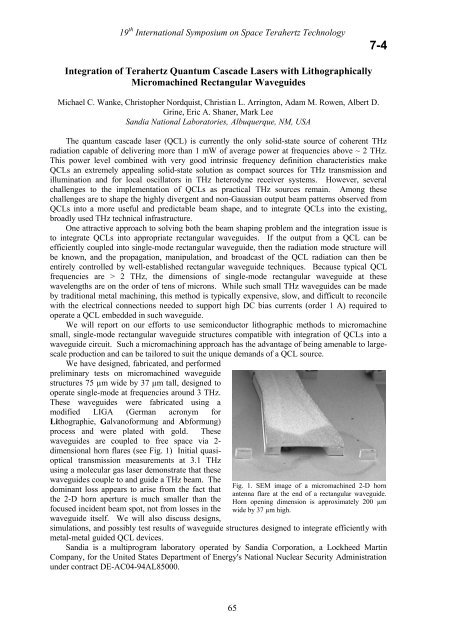Program and Abstract Book - SRON
Program and Abstract Book - SRON
Program and Abstract Book - SRON
You also want an ePaper? Increase the reach of your titles
YUMPU automatically turns print PDFs into web optimized ePapers that Google loves.
19 th International Symposium on Space Terahertz Technology<br />
7-4<br />
Integration of Terahertz Quantum Cascade Lasers with Lithographically<br />
Micromachined Rectangular Waveguides<br />
Michael C. Wanke, Christopher Nordquist, Christian L. Arrington, Adam M. Rowen, Albert D.<br />
Grine, Eric A. Shaner, Mark Lee<br />
S<strong>and</strong>ia National Laboratories, Albuquerque, NM, USA<br />
The quantum cascade laser (QCL) is currently the only solid-state source of coherent THz<br />
radiation capable of delivering more than 1 mW of average power at frequencies above ~ 2 THz.<br />
This power level combined with very good intrinsic frequency definition characteristics make<br />
QCLs an extremely appealing solid-state solution as compact sources for THz transmission <strong>and</strong><br />
illumination <strong>and</strong> for local oscillators in THz heterodyne receiver systems. However, several<br />
challenges to the implementation of QCLs as practical THz sources remain. Among these<br />
challenges are to shape the highly divergent <strong>and</strong> non-Gaussian output beam patterns observed from<br />
QCLs into a more useful <strong>and</strong> predictable beam shape, <strong>and</strong> to integrate QCLs into the existing,<br />
broadly used THz technical infrastructure.<br />
One attractive approach to solving both the beam shaping problem <strong>and</strong> the integration issue is<br />
to integrate QCLs into appropriate rectangular waveguides. If the output from a QCL can be<br />
efficiently coupled into single-mode rectangular waveguide, then the radiation mode structure will<br />
be known, <strong>and</strong> the propagation, manipulation, <strong>and</strong> broadcast of the QCL radiation can then be<br />
entirely controlled by well-established rectangular waveguide techniques. Because typical QCL<br />
frequencies are > 2 THz, the dimensions of single-mode rectangular waveguide at these<br />
wavelengths are on the order of tens of microns. While such small THz waveguides can be made<br />
by traditional metal machining, this method is typically expensive, slow, <strong>and</strong> difficult to reconcile<br />
with the electrical connections needed to support high DC bias currents (order 1 A) required to<br />
operate a QCL embedded in such waveguide.<br />
We will report on our efforts to use semiconductor lithographic methods to micromachine<br />
small, single-mode rectangular waveguide structures compatible with integration of QCLs into a<br />
waveguide circuit. Such a micromachining approach has the advantage of being amenable to largescale<br />
production <strong>and</strong> can be tailored to suit the unique dem<strong>and</strong>s of a QCL source.<br />
We have designed, fabricated, <strong>and</strong> performed<br />
preliminary tests on micromachined waveguide<br />
structures 75 µm wide by 37 µm tall, designed to<br />
operate single-mode at frequencies around 3 THz.<br />
These waveguides were fabricated using a<br />
modified LIGA (German acronym for<br />
Lithographie, Galvanoformung <strong>and</strong> Abformung)<br />
process <strong>and</strong> were plated with gold. These<br />
waveguides are coupled to free space via 2-<br />
dimensional horn flares (see Fig. 1) Initial quasioptical<br />
transmission measurements at 3.1 THz<br />
using a molecular gas laser demonstrate that these<br />
waveguides couple to <strong>and</strong> guide a THz beam. The<br />
dominant loss appears to arise from the fact that<br />
the 2-D horn aperture is much smaller than the<br />
focused incident beam spot, not from losses in the<br />
Fig. 1. SEM image of a micromachined 2-D horn<br />
antenna flare at the end of a rectangular waveguide.<br />
Horn opening dimension is approximately 200 µm<br />
wide by 37 µm high.<br />
waveguide itself. We will also discuss designs,<br />
simulations, <strong>and</strong> possibly test results of waveguide structures designed to integrate efficiently with<br />
metal-metal guided QCL devices.<br />
S<strong>and</strong>ia is a multiprogram laboratory operated by S<strong>and</strong>ia Corporation, a Lockheed Martin<br />
Company, for the United States Department of Energy's National Nuclear Security Administration<br />
under contract DE-AC04-94AL85000.<br />
65
















